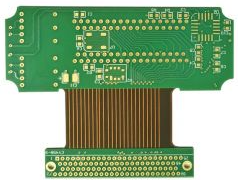1. For a group of buses (address, data, command) to drive multiple (up to 4, 5) devices (FLASH, SDRAM, other peripherals...), which method is used when PCB wiring?
The influence of the wiring topology on the signal integrity is mainly reflected in the inconsistent signal arrival time on each node, and the reflected signal also arrives at a certain node in the same time, which causes the signal quality to deteriorate. Generally speaking, in a star topology, you can control several stubs of the same length to make the signal transmission and reflection delays consistent to achieve better signal quality. Before using the topology, the situation of the signal topology node, the actual working principle and the wiring difficulty should be considered. Different buffers have inconsistent effects on signal reflection, so the star topology cannot solve the delay of the data address bus connecting to flash and sdram, and thus cannot ensure the quality of the signal; on the other hand, high-speed signals generally For communication between dsp and sdram, the speed of flash loading is not high, so in high-speed simulation, you only need to ensure the waveform at the node where the actual high-speed signal works effectively, instead of paying attention to the waveform at the flash; star topology is compared with daisy chain and other topologies. In other words, wiring is more difficult, especially when a large number of data address signals use star topology. The attached figure is the simulation waveform of using Hyperlynx simulation data signal in DDR--DSP--FLASH topology connection, and DDR--FLASH--DSP connection at 150MHz. It can be seen that in the second case, the signal quality at the DSP is better, but the waveform at the FLASH is worse, and the actual working signal is the waveform at the DSP and DDR.
2. For PCB with frequency above 30M, use automatic wiring or manual wiring when wiring; are the software functions of wiring the same?

Whether the high-speed signal is based on the rising edge of the signal rather than the absolute frequency or speed. Automatic or manual wiring depends on the support of the software wiring function. Some wiring may be better than automatic wiring manually, but for some wiring, such as checking distribution lines, bus delay compensation wiring, the effect and efficiency of automatic wiring will be much higher than manual wiring. Generally, the substrate of PCB copy board is mainly composed of a mixture of resin and glass cloth. Due to the different proportions, the dielectric constant and thickness are different. Generally, the higher the resin content, the smaller the dielectric constant, the thinner it can be. For specific parameters, please consult the PCB manufacturer. In addition, with the emergence of new processes, there are also PCB boards of some special materials that are provided for such as ultra-thick backplanes or low-loss RF boards.
3. In PCB design, the ground wire is usually divided into protective ground and signal ground; power ground is divided into digital ground and analog ground. Why should the ground wire be divided?
The purpose of dividing the ground is mainly for EMC considerations, and it is worried that the noise on the digital part of the power supply and the ground will interfere with other signals, especially analog signals through the conduction path. As for the division of signal and protective ground, it is because the consideration of ESD static discharge in EMC is similar to the role of lightning rod grounding in our lives. No matter how you divide it, there is only one land in the end. It's just that the noise emission method is different.
4. Is it necessary to add ground wire shields on both sides when fabricating the clock?
Whether to add a shielded ground wire or not depends on the crosstalk/EMI situation on the board, and if the shielded ground wire is not handled well, it may make the situation worse.
5. What are the corresponding countermeasures when deploying clock lines of different frequencies?
For the wiring of the clock line, it is best to perform signal integrity analysis, formulate corresponding wiring rules, and perform wiring according to these rules.
6. When the PCB single-layer board is manually wired, should it be placed on the top layer or the bottom layer? If the device is placed on the top layer, the bottom layer is routed.